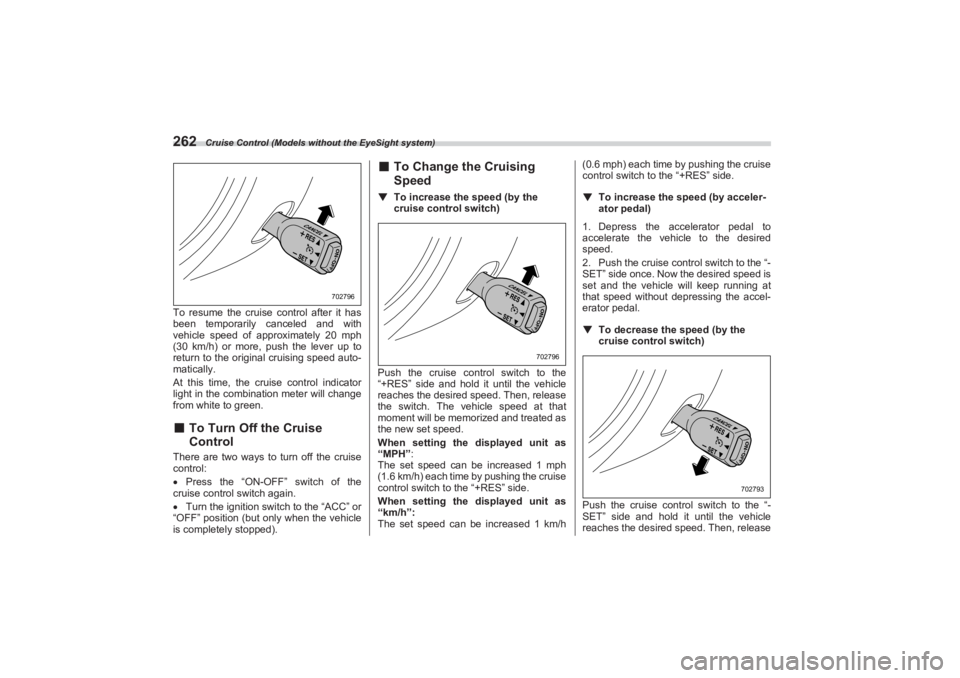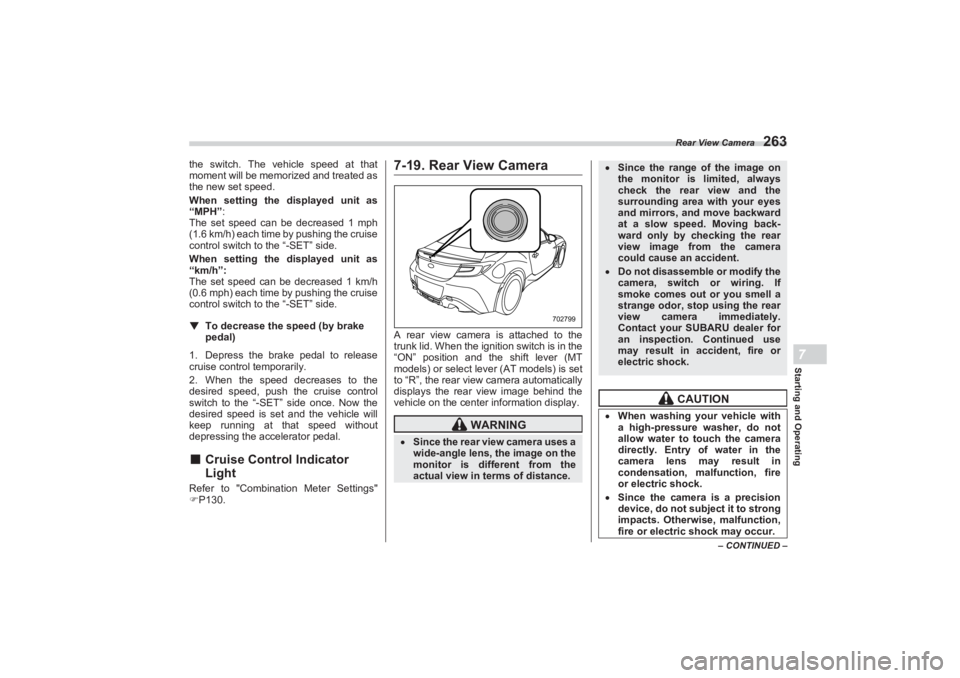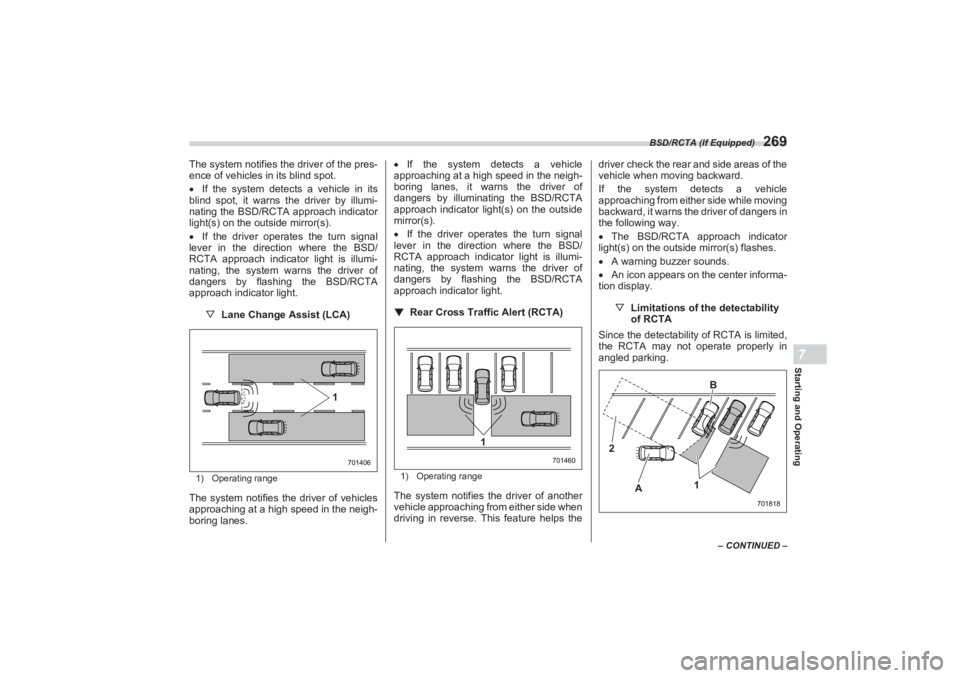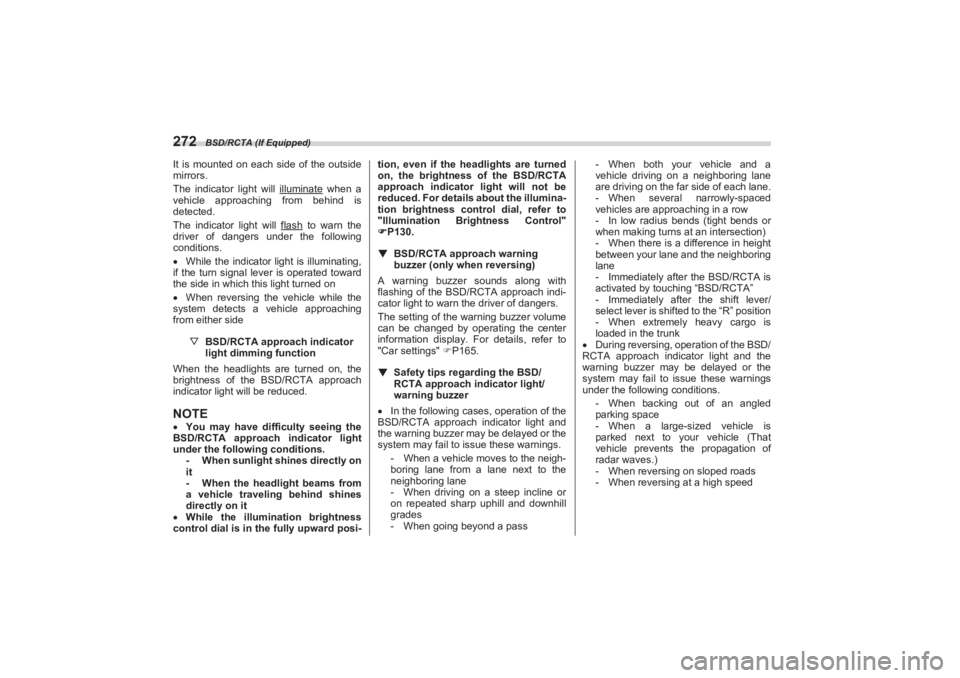2023 SUBARU BRZ display
[x] Cancel search: displayPage 268 of 432

Cruise Control (Models without the EyeSight system)
262To resume the cruise control after it has
been temporarily canceled and with
vehicle speed of approximately 20 mph
(30 km/h) or more, pu sh the lever up to
return to the original cruising speed auto-
matically.
At this time, the cruise control indicator
light in the combination meter will change
from white to green.■ To Turn Off the Cruise
ControlThere are two ways to turn off the cruise
control:
Press the “ON-OFF” switch of the
cruise control switch again.
Turn the ignition switch to the “ACC” or
“OFF” position (but only when the vehicle
is completely stopped).
■ To Change the Cruising
Speed▼ To increase the speed (by the
cruise control switch)
Push the cruise cont rol switch to the
“+RES” side and hold it until the vehicle
reaches the desired speed. Then, release
the switch. The vehicle speed at that
moment will be memorized and treated as
the new set speed.
When setting the displayed unit as
“MPH”:
The set speed can be increased 1 mph
(1.6 km/h) each time by pushing the cruise
control switch to the “+RES” side.
When setting the displayed unit as
“km/h”:
The set speed can be increased 1 km/h (0.6 mph) each time by pushing the cruise
control switch to the “+RES” side.
▼ To increase the speed (by acceler -
ator pedal)
1. Depress the accelerator pedal to
accelerate the vehicle to the desired
speed.
2. Push the cruise control switch to the “-
SET” side once. Now the desired speed is
set and the vehicle will keep running at
that speed without depressing the accel-
erator pedal.
▼ To decrease the speed (by the
cruise control switch)
Push the cruise cont rol switch to the “-
SET” side and hold it until the vehicle
reaches the desired speed. Then, release
702796
702796
702793
BRZ_U.book 262 ページ 2022年3月29日 火曜日 午後3時59分
Page 269 of 432

Rear View Camera
263
Starting and Operating7
– CONTINUED –
the switch. The vehicle speed at that
moment will be memorized and treated as
the new set speed.
When setting the displayed unit as
“MPH”:
The set speed can be decreased 1 mph
(1.6 km/h) each time by pushing the cruise
control switch to the “-SET” side.
When setting the displayed unit as
“km/h”:
The set speed can be decreased 1 km/h
(0.6 mph) each time by pushing the cruise
control switch to the “-SET” side.▼ To decrease the speed (by brake
pedal)
1. Depress the brake pedal to release
cruise control temporarily.
2. When the speed decreases to the
desired speed, push the cruise control
switch to the “-SET” side once. Now the
desired speed is set and the vehicle will
keep running at that speed without
depressing the accelerator pedal.■ Cruise Control Indicator
LightRefer to "Combination Meter Settings"
P130.
7-19. Rear View CameraA rear view camera is attached to the
trunk lid. When the ignition switch is in the
“ON” position and the shift lever (MT
models) or select lever (AT models) is set
to “R”, the rear view camera automatically
displays the rear view image behind the
vehicle on the center information display.
WARNING
Since the rear view camera uses a
wide-angle lens, the image on the
monitor is diffe rent from the
actual view in terms of distance.
702799
Since the range of the image on
the monitor is limited, always
check the rear view and the
surrounding area with your eyes
and mirrors, and move backward
at a slow speed. Moving back-
ward only by checking the rear
view image from the camera
could cause an accident. Do not disassemble or modify the
camera, switch or wiring. If
smoke comes out or you smell a
strange odor, stop using the rear
view camera immediately.
Contact your SUBARU dealer for
an inspection. Continued use
may result in accident, fire or
electric shock.
CAUTION
When washing your vehicle with
a high-pressure washer, do not
allow water to touch the camera
directly. Entry of water in the
camera lens may result in
condensation, malfunction, fire
or electric shock. Since the camera is a precision
device, do not subject it to strong
impacts. Otherwise, malfunction,
fire or electric shock may occur.
BRZ_U.book 263 ページ 2022年3月29日 火曜日 午後3時59分
Page 270 of 432

Rear View Camera
264NOTEDo not wipe the camera with
alcohol, benzine or paint thinner.
Otherwise, discoloration may occur.
To remove contamination, wipe the
camera with a cloth moistened with a
diluted neutral detergent. Then wipe it
with a soft, dry cloth.
When waxing the vehicle, be careful
not to apply the wax to the camera. If it
comes in contact with the camera,
moisten a clean cloth with a diluted
neutral detergent to remove the wax.
The camera lens has a hard coating
to help prevent scratches. However,
when washing the vehicle or cleaning
the camera lens, be careful not to
scratch the camera lens. Do not use a
washing brush directly on the camera
lens. The image quality of the rear view
camera may deteriorate.
Strong light shined on the camera
lens may develop vertical lines around
the light source. This is not a malfunc-
tion.
Under the fluorescent light, the
display may flicker. However, this is
not a malfunction.
The image of the rear view camera
may be slightly different from the
actual color of the objects.
If there is a malfunction on the
center information display, refer to
"Malfunctions of the Center Informa-
tion Display" P327.
■ How to Use the Rear View
CameraWhen the shift lever/se lect lever is set to
“R”, the rear view camera automatically
displays the rear view image from the vehicle. When the lever is set to other
positions, the image before setting to “R”
is displayed.
1. Set the ignition switch to “ON”.
2. Set the shift lever/ select lever to “R”.
NOTEThe image of the rear view camera is
horizontally reversed as is the case
with the vehicle inside mirror or the
outside mirror.
When “Rear Camera Delay Control”
is on, the rear view image from the rear
view camera will be displayed on the
center information display for a certain
amount of time after the shift lever (MT
models) or select lever (AT models) is
shifted from “R” to another position.
When any of the following conditions
are met, the rear view image will be
canceled: - The select lever is shifted to “P”
(AT models)
- The vehicle speed becomes
approximately 5 mph (8 km/h) or
more
- The parking brake is engaged
- 9 seconds have elapsed since
the shift lever (MT models) or select
lever (AT models) was shifted from
“R” to another position
If mud or snow sticks to or is
frozen on the camera, you must
be very careful when removing it.
Otherwise, damage to the camera
may cause a fire or electric shock.
Pour water or lukewarm water
over the camera to remove mud
and ice, and wipe it with a soft,
dry cloth. Do not put a flame close to the
camera or wiring. Otherwise,
damage or fire may occur. When replacing the fuse, be sure
to use a fuse with the specified
rating. Use of a fuse with a
different rating may result in a
malfunction. If you use the rear view camera
for a long time wh ile the engine is
not operated, the battery may
become completely discharged.
BRZ_U.book 264 ページ 2022年3月29日 火曜日 午後3時59分
Page 272 of 432

Rear View Camera
266Range of view
Image from cameraThe area above the camera cannot be
viewed. If there is an object that has a
wide projection on its upper part such as a
sign pole behind the vehicle, the projec-
tion cannot be seen on the screen.■ Help LinesThe help lines are a guide to help you
realize the actual distance from the screen
image.NOTEIf you shift to the “R” range within sev-
eral seconds after turning on the igni-
tion switch, the warning message may
not be displayed. Wait for several sec-
onds after turning on the ignition switch before shif
ting to the “R”
range. Then, the warning message will
be displayed.
Help lines
1) Vehicle width line (oblique vertical line)
2) Approx. 10 ft (3 m) from the bumper
(green horizontal line)
3) Approx. 6 ft (2 m) from the bumper
(green horizontal line)
4) Approx. 3 ft (1 m) from the bumper
(yellow horizontal line)
5) Approx. 1.5 ft (0.5 m) from the bumper
(red horizontal line)
6) Vehicle centerline
7) Dynamic guidelinesWhen the shift lever/se lect lever is set to
“R”, the monitor screen displays the help
lines together with the rear view image.
NOTEWhen “Steering Angle Lines” is off,
the dynamic guidelines will be disap-
pear on the center information display.
To turn the dynamic guidelines on and
off, refer to "G eneral settings" P161.
▼ Difference between screen image
and actual roadThe distance markers show the distance
for a level road when the vehicle is not
loaded. It may be different from the actual
distance depending on the loading condi-
tions or road conditions.
601105
702392
5 4
3
2 1
6 7
Check Surroundings Before Backing Up
CAUTION
When moving backward, always
check the back with your eyes
without relying on the help lines.
Otherwise, it may cause an acci-
dent or injury. The actual position may be
different from the indication of
the help lines. Differences may oc cur due to the
number of passengers or the
loaded cargo. When the vehicle is on a slope or
inclined against the road, the
indication is diffe rent from the
actual position.
BRZ_U.book 266 ページ 2022年3月29日 火曜日 午後3時59分
Page 273 of 432

Rear View Camera
267
Starting and Operating7
▽When there is an upward slope
at the back1) 3 ft (1 m)The distance on the screen looks farther
than the actual distance. ▽
When there is a downward slope
at the back
1) 3 ft (1 m)The distance on the screen looks nearer
than the actual distance.NOTEWhen cargo is loaded, the rear view
distance on the screen looks farther
than the actual distance as in an
upward slope. ▼
Feature of distance marker
1) 3 ft (1 m) line
2) 10 ft (3 m) lineThe distance marker shows the distance
on the road. If there is a car or another
object close behind, distance cannot be
correctly displayed.
601501
1
601502
1
601673
2
1
BRZ_U.book 267 ページ 2022年3月29日 火曜日 午後3時59分
Page 275 of 432

BSD/RCTA (If Equipped)
269
Starting and Operating7
– CONTINUED –
The system notifies the driver of the pres-
ence of vehicles in its blind spot.
If the system detects a vehicle in its
blind spot, it warns the driver by illumi-
nating the BSD/RCTA approach indicator
light(s) on the outside mirror(s).
If the driver operates the turn signal
lever in the direction where the BSD/
RCTA approach indicator light is illumi-
nating, the system warns the driver of
dangers by flashing the BSD/RCTA
approach indicator light.
▽ Lane Change Assist (LCA)1) Operating rangeThe system notifies the driver of vehicles
approaching at a high speed in the neigh-
boring lanes.
If the system detects a vehicle
approaching at a high speed in the neigh-
boring lanes, it warns the driver of
dangers by illuminating the BSD/RCTA
approach indicator light(s) on the outside
mirror(s).
If the driver operates the turn signal
lever in the direction where the BSD/
RCTA approach indicator light is illumi-
nating, the system warns the driver of
dangers by flashing the BSD/RCTA
approach indicator light.
▼ Rear Cross Traffic Alert (RCTA)
1) Operating rangeThe system notifies the driver of another
vehicle approaching from either side when
driving in reverse. This feature helps the driver check the rear and side areas of the
vehicle when moving backward.
If the system detects a vehicle
approaching from either side while moving
backward, it warns the driver of dangers in
the following way.
The BSD/RCTA approach indicator
light(s) on the outside mirror(s) flashes.
A warning buzzer sounds.
An icon appears on the center informa-
tion display.
▽Limitations of the detectability
of RCTA
Since the detectabilit y of RCTA is limited,
the RCTA may not operate properly in
angled parking.
701406
1
701460
1
701818
2
A B
1
BRZ_U.book 269 ページ 2022年3月29日 火曜日 午後3時59分
Page 278 of 432

BSD/RCTA (If Equipped)
272It is mounted on each side of the outside
mirrors.
The indicator light will illuminate
when a
vehicle approaching from behind is
detected.
The indicator light will flash
to warn the
driver of dangers under the following
conditions.
While the indicator light is illuminating,
if the turn signal lever is operated toward
the side in which this light turned on
When reversing the vehicle while the
system detects a vehicle approaching
from either side
▽ BSD/RCTA approach indicator
light dimming function
When the headlights are turned on, the
brightness of the BSD/RCTA approach
indicator light will be reduced.
NOTE You may have difficulty seeing the
BSD/RCTA approach indicator light
under the following conditions. - When sunlight shines directly on
it
- When the headlight beams from
a vehicle traveling behind shines
directly on it
While the illumination brightness
control dial is in the fully upward posi- tion, even if the headlights are turned
on, the brightness of the BSD/RCTA
approach indicator light will not be
reduced. For details about the illumina-
tion brightness control dial, refer to
"Illumination Brightness Control"
P130.
▼ BSD/RCTA approach warning
buzzer (only when reversing)
A warning buzzer sounds along with
flashing of the BSD/RCTA approach indi-
cator light to warn the driver of dangers.
The setting of the warning buzzer volume
can be changed by operating the center
information display. For details, refer to
"Car settings" P165.
▼ Safety tips regarding the BSD/
RCTA approach indicator light/
warning buzzer
In the following cases, operation of the
BSD/RCTA approach indicator light and
the warning buzzer may be delayed or the
system may fail to issue these warnings.
- When a vehicle moves to the neigh-
boring lane from a lane next to the
neighboring lane
- When driving on a steep incline or
on repeated sharp uphill and downhill
grades
- When going beyond a pass - When both your vehicle and a
vehicle driving on a neighboring lane
are driving on the far side of each lane.
- When several narrowly-spaced
vehicles are approaching in a row
- In low radius bends (tight bends or
when making turns at an intersection)
- When there is a difference in height
between your lane and the neighboring
lane
- Immediately after the BSD/RCTA is
activated by touching “BSD/RCTA”
- Immediately after the shift lever/
select lever is shifted to the “R” position
- When extremely heavy cargo is
loaded in the trunk
During reversing, operation of the BSD/
RCTA approach indicator light and the
warning buzzer may be delayed or the
system may fail to issue these warnings
under the following conditions.
- When backing out of an angled
parking space
- When a large-sized vehicle is
parked next to your vehicle (That
vehicle prevents the propagation of
radar waves.)
- When reversing on sloped roads
- When reversing at a high speedBRZ_U.book 272 ページ 2022年3月29日 火曜日 午後3時59分
Page 279 of 432

BSD/RCTA (If Equipped)
273
Starting and Operating7
– CONTINUED –
The BSD/RCTA approach indicator
light may illuminate when driving close to
solid objects on the road or road side
(such as guardrails, tunnels and side-
walls).
When turning at an intersection in
urban areas, or a multilane intersection,
the BSD/RCTA approach indicator light
may flash.
If a building or a wall exists in the
reversing direction, the BSD/RCTA
approach indicator light may flash and the
warning buzzer may sound.
In the following cases, the system may
detect a vehicle driving two lanes away
from your vehicle.
- When your vehicle drives on the
near side of its lane from the corre-
sponding vehicle - When the vehicle driving two lanes
away drives on the near side of its lane
from your vehicle
■ BSD/RCTA OFF Indicator▼ System temporary stops1) BSD/RCTA temporary stop message
2) BSD/RCTA OFF indicatorThis display appears when the system is
used at extremely high or low tempera-
tures or when abnormal voltage exists.
Once these conditions are corrected, the
system will recover from the temporary
stop condition and the indicator will disap-
pear.
If the indicator remains displayed for a
prolonged time, have the system
inspected at a SUBARU dealer. ▼
System temporary stops due to
reduced radar sensitivity
1) BSD/RCTA temporary stop message
due to reduced radar sensitivity
2) BSD/RCTA OFF indicatorThis display appears when the detect-
ability of the radar sensors is reduced.
Once the condition is corrected, the
system will recover from the temporary
stop condition and the indicator will disap-
pear.
If the indicator rema ins displayed for a
prolonged time, have the system
inspected at a SUBARU dealer.
702802
1
2
702877
1
2
702878
BRZ_U.book 273 ページ 2022年3月29日 火曜日 午後3時59分